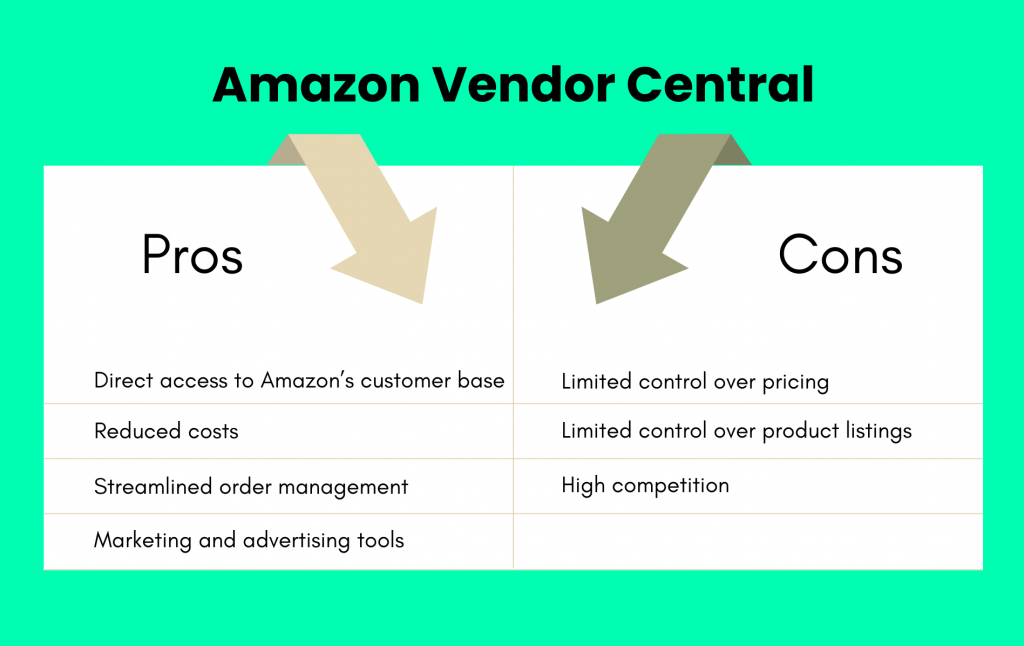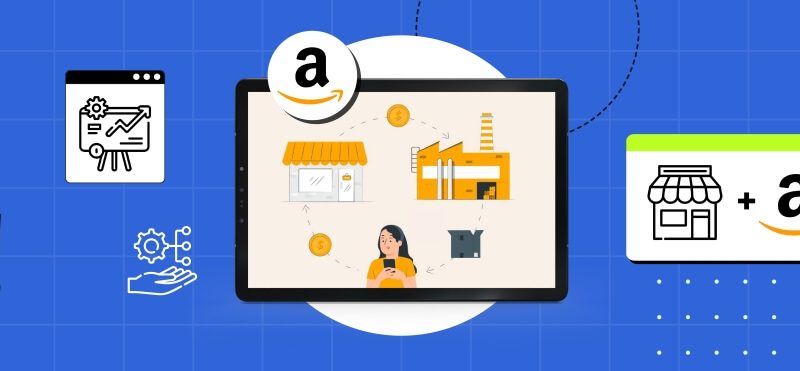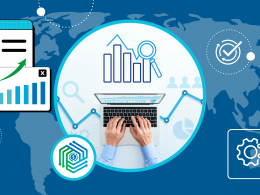Amazon Vendor Central is an online platform that allows businesses to sell their products to Amazon as a wholesale supplier. This platform has been designed specifically for manufacturers and distributors who are looking to sell their products in large quantities to Amazon.
Thus, Amazon Vendor Central is an essential tool for businesses looking to reach millions of customers on the world’s largest online marketplace.
In this article, we’ll explore what Amazon Vendor Central is, how it works, and the benefits of using it for your business.
Contents:
1. What is Amazon Vendor Central?
2. What is the difference between FBA and Amazon Vendor Central?
3. How to become a vendor on the Vendor Central on Amazon
4. How does a vendor get invited to Vendor Central on Amazon
5. How to log into your Vendor Central account on Amazon?
6. How does the Vendor Central on Amazon work?
7. Is Vendor Central accessible to Amazon vendors located in Europe?
8. Are Amazon Seller Central and Vendor Central the same?
9. Can you have accounts on both Amazon Seller Central and Vendor Central?
10. Pros and Cons of using Vendor Central
11. What fees a vendor can expect to pay on Vender Central on Amazon
12. Best practices for becoming a top vendor on Vendor Central on Amazon
What is Amazon Vendor Central?
Amazon Vendor Central is an invitation-only platform for manufacturers and distributors who are looking to sell their products to Amazon as a wholesale supplier. This platform is different from Amazon Seller Central, which is an open platform for businesses and individuals looking to sell their products directly to Amazon customers. Amazon Vendor is designed for businesses that are looking to sell their products in bulk to Amazon.
One of the main benefits of using Amazon Vendor Central is that it allows businesses to sell their products directly to Amazon, rather than having to go through third-party resellers or distributors. This can help businesses reduce their costs and increase their profit margins, as they’re selling their products directly to Amazon at a wholesale price.
Another benefit of using Amazon Vendor is that it provides businesses with access to Amazon’s vast customer base. Amazon has millions of active customers worldwide, and by selling your products on Amazon Vendor Central, you can reach a larger audience than you would be able to by selling on your own website or through other sales channels.
What is the difference between FBA and Amazon Vendor Central?
Fulfillment by Amazon (FBA) and Amazon Vendor Central are two different programs that offer different benefits and services to sellers on Amazon. The key differences between the two programs are:
- Ownership of inventory. With FBA, sellers own and store their inventory in Amazon’s warehouses, while with Vendor Central, Amazon owns and stores the inventory.
- Sales and pricing control. When using FBA, sellers have more control over their pricing and can manage their own marketing campaigns. With Vendor Central, Amazon sets the pricing and controls the product listing and marketing campaigns.
- Payment terms. With FBA, sellers receive payment for their sales immediately, while with Vendor Central, Amazon pays vendors according to their agreed-upon payment terms.
- Eligibility. FBA is available to any seller who meets the requirements, while Vendor Central is an invitation-only program that is typically offered to large manufacturers and distributors.
- Shipping and customer service. When using Amazon FBA, Amazon handles shipping and customer service for the seller. With Vendor Central, the seller is responsible for shipping their inventory to Amazon and providing customer service to their customers.
So, in simple words, FBA is a program for sellers to store their inventory in Amazon’s fulfillment centers and use Amazon’s logistics and customer service network to fulfill orders.
In contrast, Vendor Central is an invitation-only program where Amazon buys inventory from large manufacturers and distributors and sells it on the Amazon marketplace.
Want to thrive on Amazon FBA? Find out what products are FBA top-sellers and boost your sales game in no time.
How to become a vendor on the Vendor Central on Amazon
To become an Amazon vendor, you must first receive an invitation from Amazon. Amazon invites businesses to become vendors based on a variety of factors, including the quality and popularity of their products, their sales history, and their reputation in the industry.
Once you’ve received an invitation from Amazon, you can begin the application process. The application process typically involves submitting detailed information about your business, including your company’s history, financial information, and product details. Amazon will also conduct a review of your business and may request additional information or documentation as needed.
The application process can take several weeks or even months, depending on the complexity of your business and the volume of products you’re looking to sell. To increase your chances of being accepted as an Amazon vendor, it’s important to provide as much information as possible about your business and to ensure that your products meet Amazon’s quality and safety standards.
How does a vendor get invited to Vendor Central on Amazon
To get invited to Amazon Vendor Central, you need to meet certain eligibility criteria and have a strong track record of selling products on the Amazon marketplace that meet Amazon’s quality and safety standards. Here are some steps you can take to increase your chances of getting an invitation to Vendor Central:
Build a strong reputation
Amazon looks for businesses that have a strong reputation in their industry and are well-regarded by their customers. Focus on building a positive reputation by providing high-quality products and excellent customer service.
Meet Amazon’s quality and safety standards
Amazon has strict standards for product quality and safety, and items that don’t satisfy the standards won’t make it to the Amazon marketplace. Make sure your products meet these standards by following best practices for product development and manufacturing.
Build a strong sales history
Amazon looks for businesses that have a proven track record of selling products on their platform. Focus on building your sales history by using other Amazon programs, such as Fulfillment by Amazon (FBA) or Seller Central.
Be prepared to meet demand
Amazon wants to work with businesses that are able to meet demand and fulfill orders in a timely manner. Make sure you have the infrastructure and resources in place to handle large orders and meet delivery deadlines.
Keep an eye out for invitations
Amazon typically sends invitations to join Vendor Central to businesses that meet their criteria. Keep an eye on your email inbox and Amazon Seller Central account for any invitations that may come your way.
How to log into your Vendor Central account on Amazon?
To log into Amazon Vendor, follow these steps:
- Go to the Amazon Vendor Central website (vendorcentral.amazon.com).
- Click on the “Sign In” button in the top right corner of the page.
- Enter your Vendor Central email address and password in the appropriate fields.
- Click on the “Sign in” button to access your Central account.
- If you’ve forgotten your password, click on the “Forgot your password?” link on the login page and follow the prompts to reset your password.
By logging into your Central account, you can access a range of tools and features to help you manage your wholesale relationship with Amazon, including order management, payment management, and marketing and advertising tools.
How does the Vendor Central on Amazon work?
Amazon Vendor Central provides businesses with a range of tools and features to help them manage their wholesale relationship with Amazon. Once you become an Amazon vendor, you can log into the Vendor Central platform to access a range of tools and features, including:
- Order management. Vendor Central provides businesses with a centralized platform for managing their orders from Amazon. Businesses can view and track their orders, manage their inventory levels, and update their product information as needed.
- Payment management. Amazon pays each Amazon vendor on a regular basis for the products they sell. Vendor Central provides businesses with a detailed view of their payment history, including payment amounts, dates, and invoices.
- Marketing and advertising. Vendor Central provides businesses with a range of marketing and advertising tools to help them promote their products on Amazon. These tools include the ability to create product listings, manage sponsored product ads, and participate in promotions and deals.
Is Vendor Central accessible to Amazon vendors located in Europe?
Amazon Vendor Central is available for Amazon vendors in both Europe and the USA, but there are some key differences between the two programs.
- Market size. The European market is generally smaller than the US market, which can affect sales volume and the number of customers you can reach.
- Shipping and logistics. Shipping and logistics may be more complex in Europe due to the many countries and languages involved. Amazon has a range of fulfillment centers and shipping options available to vendors in both regions, but it’s important to carefully consider your logistics strategy when selling in Europe.
- Payment terms. Payment terms for Vendor Central vary by region, with different payment schedules and methods available in Europe and the US.
- VAT compliance. VAT compliance is a critical consideration for selling in Europe, as VAT rates vary by country and sellers are responsible for collecting and remitting VAT to the appropriate authorities.
- Language and cultural differences. Europe is a diverse region with many different languages and cultures, which can affect your product listing and marketing strategies. It’s important to consider local customs and preferences when selling in different countries in Europe.
Despite these differences, the core features and benefits of Amazon Vendor Central are largely the same in both Europe and the US. Both programs offer businesses direct access to Amazon’s customer base, a range of management tools, and marketing and advertising opportunities. In order to succeed in either, it’s important to carefully consider the pros and cons of selling in both regions and develop a clear selling strategy.
Are Amazon Seller Central and Vendor Central the same?
No, Amazon Seller Central and Vendor Central aren’t the same. They’re two different platforms with different features and benefits for sellers on Amazon.
Seller Central is an open platform that allows businesses and individuals to sell their products directly to customers on Amazon. An Amazon seller on Seller Central is responsible for managing their own inventory, shipping products to customers, and handling customer service. An Amazon seller can have more control over their pricing, product listings, and marketing campaigns on Seller Central.
Vendor Central, on the other hand, is an invitation-only program for manufacturers and distributors to sell their products to Amazon as a wholesale supplier. Vendors on Vendor Central are responsible for supplying their products to Amazon, and Amazon is responsible for managing inventory, shipping products to customers, and handling customer service. Vendors have less control over their pricing, product listings, and marketing campaigns on Vendor Central, as Amazon sets the pricing and controls your product listing and marketing campaigns.
Can you have accounts on both Amazon Seller Central and Vendor Central?
Yes, it’s possible to have both an Amazon Seller Central and an Amazon Vendor Central account. In fact, many businesses choose to use both platforms to sell their products on Amazon. Here are some things to keep in mind if you are considering using both Amazon Seller and Amazon Vendor Central:
Different account types
As mentioned before, Amazon Seller is an open platform that enables selling directly to customers on Amazon, while Vendor Central is a selective program that allows manufacturers and distributors to supply their products to Amazon as a wholesale supplier, but only by invitation from Amazon.
Different benefits
Seller Central provides businesses with more control over their pricing, product listings, and marketing campaigns, while Vendor Central provides businesses with access to Amazon’s customer base, a range of management tools, and marketing and advertising opportunities.
Different fees
Seller Central charges fees based on the number of products sold, while Vendor Central charges fees based on negotiated terms.
Different inventory ownership
With Seller Central, sellers own and manage their own inventory, while with Vendor Central, Amazon owns and manages the inventory.
Potential conflict
Using both Seller Central and Vendor Central can create potential conflicts of interest and competition with Amazon, so it’s important to carefully consider your strategy and goals before using both platforms.
While you’re at it, check out this detailed breakdown of Amazon FBA fees — they just might come in handy.
Pros and Cons of using Vendor Central
As with any sales channel, there are both advantages and disadvantages to being a Central vendor. Some of the key pros and cons of using Vendor Central include:
Pros
- Direct access to Amazon’s customer base. By selling your products on Amazon’s Vendor Central, you can reach millions of active customers worldwide.
- Reduced costs. By selling your products directly to Amazon at wholesale prices, you can reduce your costs and increase your profit margins.
- Streamlined order management. Vendor Central provides businesses with a centralized platform for managing their orders from Amazon, making it easier to manage inventory levels and fulfill orders in a timely manner.
- Marketing and advertising tools. Vendor Central provides businesses with a range of marketing and advertising tools to help them promote their products on Amazon and increase sales.
Cons
- Limited control over pricing. When selling your products on Amazon Vendor Central, you may have limited control over the pricing of your products. Amazon may set a price based on their own algorithms and data, which may not always align with your pricing strategy.
- Limited control over product listings. Amazon may also have some control over the product listings on their platform, which may limit your ability to showcase your products in the way that you’d like.
- High competition. With millions of active sellers on Amazon, there’s a lot of competition for sales. This can make it difficult for some businesses to stand out and make consistent sales on the platform.

What fees a vendor can expect to pay on Vender Central on Amazon
Amazon Vendor Central fees vary depending on the type of product you sell, the volume of products you sell, and the negotiated terms of your agreement with Amazon. Here are some of the key fees you can expect to pay as a vendor on Amazon:
Referral fees
Amazon charges a referral fee for each product sold through Vendor Central. The referral fee is typically a percentage of the product’s sale price, ranging from 6% to 45%, depending on the product category.
Shipping fees
If Amazon is responsible for shipping the products to customers, there may be additional shipping fees charged to the vendor. These fees vary depending on the size and weight of the products being shipped.
Marketing and advertising fees
Vendor Central provides businesses with a range of marketing and advertising tools to help them promote their products on Amazon. However, there may be additional fees associated with using these tools, such as sponsored product ads or Lightning Deals.
Chargebacks and deductions
Amazon may charge vendors for various types of deductions or chargebacks, such as for returns, damaged products, or customer refunds.
Payment terms
Vendors may be subject to negotiated payment terms with Amazon, which can affect the timing and frequency of payments received.
It’s important to carefully review the terms and conditions of your agreement with Amazon and understand the fees and charges associated with selling your products through Vendor Central you’ll have to pay.
By doing so, you can ensure that you’re pricing your products appropriately and maximizing your profitability on the platform.
However, fees won’t be your only expenses, as there are also sales taxes to take care of. Learn how to eliminate the grunt work from tax management and save yourself (or your accountant) a major headache.
Best practices for becoming a top vendor on Vendor Central on Amazon
To succeed on Amazon Vendor Central, it’s important to develop a clear strategy and follow some best practices. Some key strategies for maximizing sales and profitability on Vendor Central include:
- Optimizing your product listings. Your product listings are critical to your success on Amazon. Be sure to optimize your listings with clear and compelling product descriptions, high-quality images, and relevant keywords.
- Pricing competitively. While you may not have full control over pricing on Amazon, it’s important to price your products competitively to increase your chances of making sales.
- Managing your inventory effectively. Effective inventory management is key to meeting customer demand and avoiding stockouts. Use the tools available on Vendor Central to monitor your inventory levels and plan for future demand.
- Leveraging marketing and advertising tools. Vendor Central provides businesses with a range of marketing and advertising tools to help them promote their products on Amazon. Be sure to take advantage of these tools to increase your visibility and drive sales.
- Monitoring your performance metrics. Vendor Central provides businesses with detailed performance metrics, including sales data, customer feedback, and return rates. Be sure to monitor these metrics regularly and make adjustments to your strategy as needed.
Monitoring your metrics and KPIs adequately can be a make or break for many e-commerce businesses.
WIth Synder INSIGHTS — a powerful solution built with e-commerce companies in mind — you’ll be able to track all the vital data in real-time, avoiding anything falling through the cracks.
Sign up for a 15-day free trial or book office hours, and take Synder for a test drive.
Amazon Vendor Central: Conclusion
Amazon Vendor Central is a powerful platform for businesses looking to sell their products to Amazon as a wholesale supplier. By providing businesses with direct access to Amazon’s customer base, a range of management tools, and marketing and advertising opportunities, Vendor Central can help businesses to increase their sales and profitability on the world’s largest online marketplace.
However, it’s important to carefully consider the pros and cons of using Vendor Central and to develop a clear strategy for success on the platform. By following best practices and staying up to date with the latest trends and developments on Amazon, businesses can position themselves for long-term success on Vendor Central.







.png)
